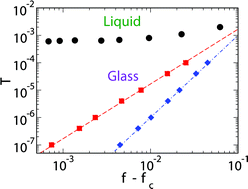Critical scaling in thermal systems near the zero-temperature jamming transition
Abstract
Within the glass regime of thermal systems with purely repulsive interactions at low temperatures, we observe two interesting phenomena associated with the zero-temperature (T = 0) jamming transition. The first one is the presence of a plateau in the density of vibrational states, a reminiscing special vibrational feature of the T = 0 jamming transition. Interestingly, the flattening of the density of vibrational states is accompanied by isostaticity, i.e. the average coordination number is equal to the isostatic value. The second one is the jamming-like transition marked by the emergence of a maximum height of the first peak of the pair distribution function, gmax1, along the trajectory of compression at a fixed temperature. We find that gmax1 is accompanied by significant change of material properties and thus divides the glass regime into two parts with and without the T = 0 jamming features. The scaling laws observed at isostaticity and jamming-like transition lead to scaling collapse of structural and thermodynamic quantities, implying criticality of the T = 0 jamming transition. The distinction between dynamically defined glass transition, jamming-like transition, and isostaticity strongly coupled with the flattening of the density of vibrational states indicate manifold characteristics of repulsive glasses near the T = 0 jamming transition.


 Please wait while we load your content...
Please wait while we load your content...